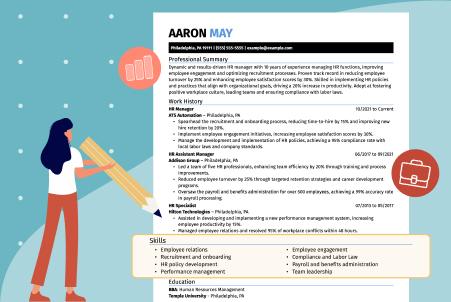Understanding Workplace Core Competencies: Definitions & Practical Examples

Our customers have been hired at: *Foot Note
Whether you’re a recent graduate entering the workforce, changing careers or an experienced professional seeking new opportunities in your field, understanding and stating your core competencies can significantly enhance your resume!
By strategically highlighting your core competencies, you can create a compelling resume that showcases your attributes but also aligns yourself more closely with the job requirements.
In this guide, we will:
- Present core competencies meaning and examples.
- Give you guidelines to identify your core competencies.
- Offer tips for adding a core competency section on your resume.
With our Resume Builder, you can customize your core competencies section and increase your chances of getting noticed!
What are core competencies?
Core competencies, also known as core qualifications, consist of a list of specific skills, knowledge and attributes that are key for a specific role. They showcase your strengths and areas of expertise, making you stand out from other candidates!
Your core competencies show your unique attributes that can define your professional brand. This can include technical skills, soft skills, industry-specific knowledge, language proficiency and certifications.
They should be tailored to the job description and reflect the requirements of the position you are applying for.
Why are core competencies important?
Some of the main relevance for core competencies are catching hiring managers' attention and winning over the ATS systems’ filter. By including relevant core competencies in a resume, you can increase your chances of passing through the initial screening of ATS and advance in the application process.
It is key to carefully review the keywords on the job description and tailor the core competencies section of your resume to match the specific requirements outlined by the employer.
Overall your core competencies are important because:
- They give you a competitive advantage.
- Increase the chances of catching hiring managers’ attention.
- Focus on presenting your strengths.
- They allow you to include keywords.
- Maximize productivity and effectiveness.
What is the difference between core competencies, skills and qualifications?
As you write your resume, you may wonder about the difference between core competencies, skills and qualifications. The answer is simple, while these terms are related, they each have distinct roles and purposes.
- Core competencies: Core competencies are a combination of personal attributes, technical skills and knowledge, and are often considered transferable skills across different roles and industries.
- Skills: These are specific abilities that an individual has developed through training or experience. They can be technical skills, such as proficiency in a particular software or programming language, or soft skills, such as communication or teamwork. Skills are generally more specific and can be taught or learned.
- Qualifications: These are the credentials or certifications that an individual possesses, such as a degree, license or professional designation. Qualifications are often required by employers as a prerequisite for a particular job or industry.
How to identify your core competencies?
Your window of opportunity to catch hiring managers’ attention consists of just a few seconds! To identify your core competencies you can follow these steps:
- Make a list of your skills: Start by making a list of all the skills you possess. These can be technical skills, such as programming or graphic design, or soft skills, such as communication or leadership.
- Identify your strengths: Review your list of skills and identify the ones you excel at and enjoy doing the most. These strengths are likely to be your core competencies.
Look for patterns: Analyze your list of strengths and look for patterns or themes. For example, if you notice that you excel at problem-solving, critical thinking and decision making, these skills can be grouped as a core competency.
- Review the job descriptions: Look for the job description to identify keywords and qualifications mentioned on the job posting.
Core competencies examples for your resume
Countless core competencies can apply to your desired role. Review the job descriptions and apply the ones that are most relevant to the job posting. Here are some examples:
- Communication: This is the foundation to express ideas clearly between teams, management and clients. It is one of the most sought competencies in workplaces.
- Leadership: Your leadership skills present your ability to inspire and motivate a team, delegate tasks and make decisions that align with the company's goals.
- Problem-solving: Problem-solving is one of the most desired competencies. It shows your analytical and critical thinking skills, and aptitude to identify issues, develop creative solutions and implement them.
- Time management: This encompasses your proficiency to prioritize tasks, meet deadlines and manage multiple projects simultaneously.
- Adaptability: Given that the work industry is constantly evolving, your adaptability showcases your capacity to adapt to new situations, cope with stress effectively and maintain a positive outlook.
- Teamwork: Teamwork is a crucial competency to showcase on your resume as it underscores your aptitude for collaboration, ability to thrive in a team environment, active participation in generating ideas and providing support to fellow team members.
- Customer service: Show your ability to understand and address customer needs, provide excellent service and handle complaints effectively.
- Technical skills: Your proficiency in using software, tools and equipment relevant to the job, such as coding languages, graphic design software or machinery can make you stand out from other candidates.
- Conflict resolution: This competency is crucial in any workplace as it promotes healthy communication, strengthens relationships and fosters a positive work environment.
- Risk management: It involves identifying, assessing and prioritizing risks that could negatively impact an organization's objectives or goals and then implementing strategies to mitigate or manage those risks.
- Creative thinking: Includes the ability to think divergently, generating multiple ideas and options rather than settling for the first solution that comes to mind.
- Strategic planning- It relates to the capacity to think long-term, anticipate future trends and develop proactive plans.
- Innovation: Presents your ability to generate and implement new ideas, approaches or processes to drive positive change.
- Analytical thinking: Includes the proficiency to gather, interpret and analyze data, identifying patterns and trends.
- Decision making: The capability to gather relevant information, evaluate options and make informed choices.
- Detail oriented: Refers to your ability to pay close attention to small details and ensure accuracy in work. This competency demonstrates a meticulous and thorough approach to your tasks, leaving no room for errors or oversights.
- Emotional intelligence: Shows your aptitude to recognize, understand and manage one's own emotions, as well as the emotions of others.
- Multitasking: Presents your dexterity to effectively manage and switch between multiple tasks or activities simultaneously.
- Results-oriented: Refers to the ability to focus on achieving desired outcomes and goals.
- Networking: This core competency shows your ability to build and maintain relationships with individuals and groups for professional or social purposes.
Core competencies examples by job title
Core competencies can vary based on the field, industry, role and level of experience. Here are some examples for different industries:
Registered Nurse
- Leadership and Mentorship: Led a nursing team of 15, achieving a 10% improvement in patient care quality metrics and mentoring new nurses, contributing to a 30% reduction in onboarding time.
- Electronic Health Records (EHR) Management: Maintain a 100% compliance rate with accurate and timely documentation in electronic health records, supporting efficient and coordinated care.
- Time Management and Organization: Manage multiple priorities and complex care schedules, maintaining a 98% on-time delivery rate for patient treatments and interventions.
Customer service representative:
- Conflict Resolution: Resolved 95% of customer complaints, decreasing 25% in the number of complaints escalated to higher management.
- Adaptability: Adapt to new procedures and changes in a fast-paced environment, maintaining a high level of performance and contributing to a 15% increase in process efficiency.
- Multitasking: Manage multiple tasks simultaneously, resulting in a 15% improvement in call handling time and increased customer throughput.
Teacher:
- Assessment and Evaluation: Conduct regular assessments and provide timely feedback, resulting in a 15% improvement in student performance and understanding.
- Technology Integration: Incorporate educational technology into the classroom to enhance learning experiences, resulting in a 20% increase in student digital literacy skills.
- Teamwork: Work collaboratively with colleagues and support staff to develop and implement school-wide initiatives, contributing to a 15% improvement in overall school performance metrics.
Tips for adding a core competency section on your resume
Approach your core competency section strategically and ensure that it aligns with the job requirements. Here are some tips to add your core competencies section to your resume:
- Identify your core competencies: Start by identifying the key skills, knowledge and abilities that make you stand out in your field.
- Determine your resume format: This is one of the most important steps for an effective core capacity section. To highlight your core competencies we recommend using combination or functional resumes. These formats are skill-oriented and allow you to showcase your different core competencies in various ways.
- Use bullet points: List your core competencies as a series of three to six bullet points, each highlighting a specific skill or ability.
- Quantify your core competencies: Whenever possible, include specific achievements or results that demonstrate the impact of your skills.
- Place the section strategically: Consider placing it at the top of your resume, just below your resume header and professional summary, so it immediately catches the reader’s attention. Unlike the chronological resume, which focuses on your professional summary and work experience, your combination and functional resumes will showcase your competencies.
- Write concise specific statements: Use action verbs to demonstrate the impact of your competencies.
- Customize it to the job: Every posting is different! Analyze the job description and requirements and select the core competencies that align most closely with the position’s needs.
- Keep it relevant and focused: Limit your core competency section to the most relevant and important competencies. Avoid listing too many skills that are not directly related to the job or industry you are targeting.
Key takeaways
- Core competencies should be tailored to the specific job or industry you are targeting, showcasing the skills most relevant to the position.
- Use concise and specific statements when listing your core competencies, using action verbs and quantifiable achievements to demonstrate the impact of your skills.
- Place the core competency section strategically on your resume, either at the top to immediately catch the reader's attention or towards the bottom after your work experience and education sections.
- Use combination or functional formats to highlight your core competency section.
- Customize your core competency section for each job application, analyzing the job description and requirements to select the most relevant competencies.
- Limit the number of core competencies listed (three to six) to the most important and relevant skills, focusing on quality rather than quantity.
- Use industry-specific keywords in your core competency section to increase the chances of your resume being selected by ATS systems.
FAQ
What are core competencies?
Core competencies are the unique strengths, skills and capabilities that set individuals or organizations apart from their competition. They are the foundation for achieving a competitive advantage and success in a particular field or industry.
What are AAMC core competencies?
Core competencies can vary depending on the field, industry, role and level of experience. In the case of the AAMC, core competencies specifically pertain to the essential skills and abilities expected of medical students upon completing their education. They encompass areas such as knowledge, critical thinking, communication, professionalism and cultural competence, all crucial for delivering quality patient care as future physicians.
How to list core competencies on your resume?
When listing core competencies on your resume, create a separate section dedicated to these skills and abilities. Use bullet points to succinctly outline each competency, emphasizing those that are most relevant to the job you’re applying for.
Our customers have been hired at:*Foot Note








